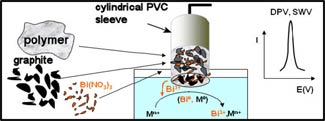Electroactive nanoparticles: a better view of environment and DNA

In the first part of this thesis a new graphite-epoxy composite electrode containing bismuth nitrate [Bi(NO3)3 -GECE)], as built-in bismuth precursor as a possible alternative for electrochemical stripping analysis of trace heavy metals has been developed. (See Figure 1).
Individual and simultaneous measurements of Pb and Cd were carried out and the results clearly showed the advantages of the [Bi(NO3)3-GECE] in combination with square wave anodic stripping voltammetry (SWASV) technique for heavy metals detection. Fast and effective analyses of trace metal ions such as Pb and Cd among others in environmental samples of soil, natural waters and effluents can be carried out by using the new [Bi(NO3)3-GECE)] constructed. The inherent advantage of no necessity of mercury removes many of the objections for the use of the developed sensor. The electrode surface can be polished after each measurement and be used with the same efficiency for others measurements due to the robustness of the sensor.
When comparing the [Bi(NO3)3-GECE)] with the commonly used mercury film electrode and previously developed bismuth film electrode, the newly proposed electrode offers a remarkable performance in analysis of trace heavy metals, which can be advantageous in electrochemical, hence contributing to the wider applicability of electrochemical stripping techniques in connection with "mercury-free" electrodes. Beside environmental applications the developed bismuth based electrode would have special interest for application to heavy metal based quantum dots. Such applications are currently in the studying process at our research group for DNA detection.
The other parts of the thesis are dedicated to the application of electrochemical stripping analysis in connection to gold nanoparticles (AuNPs) for DNA.
Currently the electrochemical detection of specific DNA sequences via hybridization event is an important issue by which diverse strategies have been proposed. Affinity electrochemical genosensors based on labeling with AuNPs and the use of paramagnetic beads (MB) as platform for the immobilization of capture DNA probe have been also developed in this thesis in order to demonstrate the effective magnetic triggering of a new magnetic-graphite epoxy composite electrode (M-GECE) which was constructed with graphite-epoxy composite paste, with a small neodymium magnet integrated. See Figure 2-A. In addition to the advantage of its use as capture platform, the MB can be separated from other species simply by applying a magnetic force during a short time (~30 s), in contrast to conventional bioseparation processes (usually hours), such as chromatography and centrifugation.
All the assays for the DNA hybridization electrochemical detection developed in this thesis were based on the direct detection of AuNPs labels (anchored onto the surface of M-GECE) by means of differential pulse voltammetry (DPV). The intensity of the generated current is directly proportional to the amount of DNA at the sample.
As also has been demonstrated, with this magnetically assisted DNA sensor, target DNA leaded to very well defined signal whereas essentially no signal was observed for non-complementary DNA. On the other hand, the identification of single-three base mismatch in the target DNA can be detected with this genosensor.
By the other side a novel, sensitive electrochemical immunoassay has been also developed based in AuNPs as label and MB as platform. The method was studied and evaluated for a noncompetitive heterogeneous immunoassay of a human IgG as a model protein. See Figure 2-B. The electrochemical detection was carried out in the same way that as for DNA.
The thesis demonstrates that the use of MB offers unprecedented advantages. MBs are sufficiently robust to allow repetitive washing under moderately stringent conditions, thus exhibiting the ability to efficiently remove non-specific species that would affect the sensor response.
The electrochemical detection of AuNPs labels in affinity biosensors using stripping methods allows the detailed study of DNA hybridization as well as immunoreactions with interest in genosensor or immunosensor applications.
The developed detection methodologies may be very promising taking into account their high sensitivity, low detection limit, selectivity, simplicity, low cost, and availability of portable instruments.
As final conclusion, the DNA and protein electrochemical analysis strategies were successfully demonstrated and according to the promising results obtained its use for real samples is viable. Such DNA biosensors and immunosensors hold an enormous application potential principally for clinical diagnostic and environmental monitoring among other fields.
Figure 2. Schematic representations (not in scale) of A) the model system and analytical protocol for DNA hybridization and electrochemical detection and B) the sandwich system for protein electrochemical detection. Both systems are based on the use of gold nanoparticles.
Departamento de Ciencias Básicas.
Universidad Autónoma Metropolitana-A. México
References
"Electrochemical Stripping Analysis and Nanoparticles for Affinity Biosensors". Doctoral thesis presented on march 14 by Maria Teresa Castañeda Briones and directed by Dr. Arben Merkoçi.


